| Columns Retired Columns & Blogs |
Merlin Excalibur II loudspeaker Measurements
Sidebar 2: Measurements
Footnote 1: See JE's and my review in August (Vol.16 No.8, p.129).—John Atkinson
With its tone controls set to maximum, the Excalibur's impedance magnitude (fig.1) stays above 4 ohms apart from the low treble, where it briefly dips to 3.3 ohms. It is actually a moderately demanding load for the amplifier driving it, the 8 ohm specification being a little optimistic. The sensitivity, assessed with B-weighted noise, is high, however, at a calculated 91dB/2.83V/m, which will reduce the demand on the partnering amplifier.
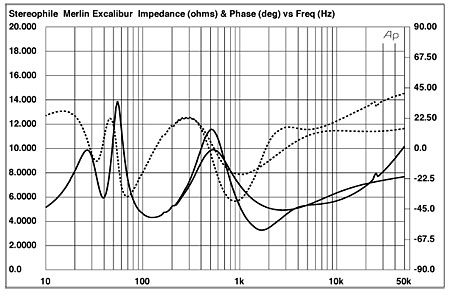
Fig.1 Merlin Excalibur, electrical impedance (solid) and phase (dashed) with tone controls set to maximum and minimum positions. (2 ohms/vertical div.)
There are a couple of wrinkles in the impedance trace between 160Hz and 250Hz, these probably due to cabinet resonances. The tuning of the port(s) in a reflex design is indicated by the frequency of the "valley" in the impedance curve between the two bass peaks. That in the Merlin lies at 39Hz, which implies rather limited bass extension for such a large enclosure.
I explore the Excalibur's bass tuning in more detail in the rather complicated-looking fig.2. Looking at the left of the graph, the blue trace with the notch at 38Hz is the output of the lower woofer, obviously reflex-loaded by the twin ports just below it. Their output is the red trace that correspondingly peaks at 38Hz. Although it, too, has twin ports (mounted on the cabinet rear), the upper woofer behaves more as if it is loaded with a sealed box. Its output (the top blue trace at 80Hz) has no reflex notch and rolls off below 60Hz or so. The output of the rear ports is the second red trace from the bottom at 40Hz; it never rises more than 12dB down from the woofer outputs, meaning that these ports really aren't doing much of anything. Both sets of ports, however, can be seen to have lower-midrange peaks in their outputs, though these are sufficiently well down that they probably won't be audible. Note that the frequencies of these peaks coincide with the wrinkle in the impedance trace.
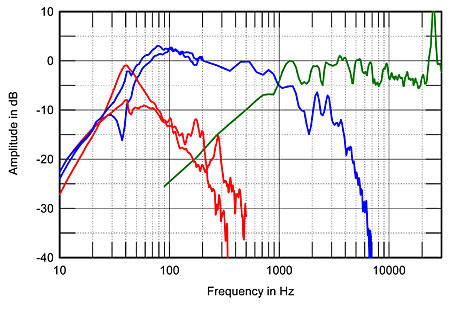
Fig.2 Merlin Excalibur, acoustic crossover on tweeter axis at 50", corrected for microphone response, with nearfield responses of the woofers (blue) and ports (red).
Moving up in frequency, the woofers go quite high (blue trace), their outputs not rolling off until well into the upper midrange. There is obvious cone-breakup behavior in the low treble noticeable in fig.2. Though this is below the midrange output (green trace), it is not far enough below that it can be discounted. It was certainly very audible on pink noise when the woofers were played by themselves. The midrange unit itself rolls off at 6dB/octave below 800Hz or so. Fig.2 also implies that the tweeter is balanced a little low in level compared with the midrange. (These curves were taken with the tone controls set to their maximum positions.)
How do all these individual responses add up? The answer can be see in fig.3, which averages the speaker's response over a 30° horizontal window centered on the tweeter axis and splices it to the complex summed magnitude of the nearfield woofer and port outputs. The Merlin's summed output features a broad hump in the midbass, where everything adds in phase. Speakers that feature this sort of midbass response profile often suffer subjectively, tending to sound congested or thickened. More importantly, note how the summed nearfield response falls off very rapidly below 38Hz or so. Because of this steep rolloff, the Excalibur can't be expected to get much help from the room in extending what low bass it has.
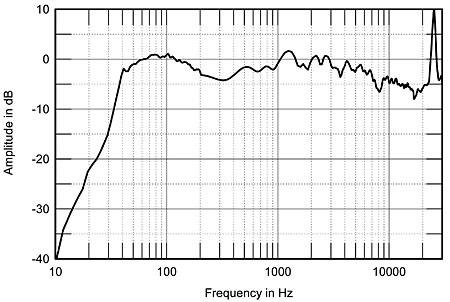
Fig.3 Merlin Excalibur, anechoic response on tweeter axis at 50" with tone controls set to maximum positions, averaged across 30° horizontal window and corrected for microphone response, with the complex sum of the nearfield responses plotted beloww 300Hz.
This is the second large, complex, heavy, and expensive loudspeaker to have passed through Santa Fe whose designer—at least in my opinion—would have done a lot better to have used a simple sealed-box alignment. That other speaker was the Clearfield Metropolitan (foonote 1) and, like that Californian design, the Excalibur offers a complex and costly type of reflex alignment that seems to succeed only in restricting its low-bass performance. Certainly a loudspeaker this large, this expensive, and this heavy that offers no more low-bass output in-room than, say, a moderately priced stand-mounted design like the $3000/pair Spendor S-100, is sonically challenged. I understand from JE that this throwing away of deep bass extension was intentional on Merlin's part. I look forward to their defense of this philosophy in "Manufacturers' Comments."
With the mid control full up, the upper midrange is balanced to be rather forward, with a slight excess of energy between 800Hz and 4kHz. The output is also rather peaky in this region. In the treble, as JE found from his auditioning, the tweeter is definitely shelved down, the top two octaves of the speaker's output being suppressed by 3–5dB before the trace in fig.3 shoots up to show the metal-dome tweeter's ultrasonic resonance at 25.4kHz. Perversely, given its inherently mellow balance, the Excalibur's tone controls only provide additional rolloff. This can be seen in fig.4, which shows just the effects of the two controls, each set to their maximum-cut positions. The midrange control generally cuts the presence region by up to 10dB; the treble control hinges down what high treble the speaker has by up to 12dB at 20kHz.
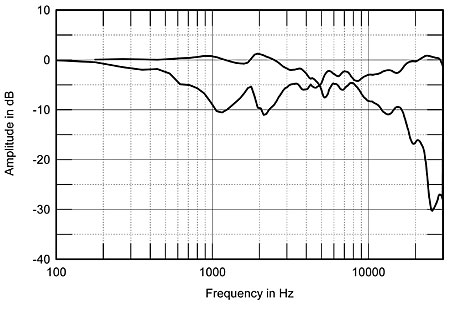
Fig.4 Merlin Excalibur, effect on HF-axis response of midrange and HF controls set to their maximum-cut positions.
Turning to the speaker's dispersion, figs.5 and 6 show how the Excalibur's balance changes as the listener moves to the side or above and below the tweeter axis. (Just the changes are shown, which is why the tweeter-axis response in both graphs appears to be a straight line. This does not mean the Excalibur's on-axis response is perfect!) Fig.5 shows that the high treble continues to roll off to the speaker's side, which means that, in addition to the attenuated highs in its direct sound, the room's reverberant field will also be significantly mellowed out.

Fig.5 Merlin Excalibur, lateral response family at 50", normalized to response on tweeter axis, from back to front: differences in response 90–5° off axis, reference response, differences in response 5–90° off axis.
This, presumably, is why Merlin recommends that the Excalibur be used in live rooms. Also note the significant peak that develops in the speaker's off-axis balance. Usually, this sort of off-axis behavior leads to a touch of brightness in a speaker's perceived balance. If the Excalibur is used in a room that is too live, or has hard-faced reflecting sidewalls close to the speaker, it may well sound too bright, even though such a room will add treble extension and air. Fig.4, however, shows that the speaker's midrange control can reduce energy in this exact region, so it might be possible to get a reasonably even treble balance overall in such a room.
Vertically (fig.6), as might be expected from a design with multiple drive-units, first-order crossovers, and significant drive-unit overlap, the balance changes significantly as the listener moves up and down. Again, however, the general trend is for there to be less treble energy above and below the tweeter axis than there is on it, exacerbating the Excalibur's already mellow on-axis balance.
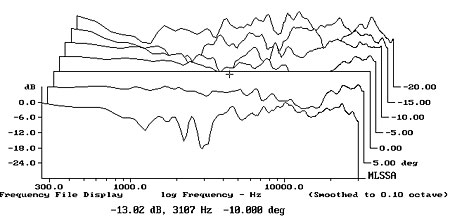
Fig.6 Merlin Excalibur, vertical response family at 50", normalized to response on tweeter axis, from back to front: differences in response 20–5° above axis, reference response, differences in response 5–10° below axis.
In the time domain, as with other speakers that use this Elac tweeter, the Excalibur's impulse response (fig.7) is dominated by the HF unit's ultrasonic ringing. The step response calculated from this impulse response (fig.8) indicates that the tweeter and midrange units are connected with opposite polarities, something confirmed by looking at the step responses of the individual units (not shown). The tweeter and both woofers have the same positive polarity, while the midrange units are connected out of phase. Interestingly, I had suspected this when performing the impedance measurements. The Audio Precision System One program defaults to a 1kHz tone at the end of the procedure; I was intrigued to hear the level of that tone increase when I disconnected the woofers.
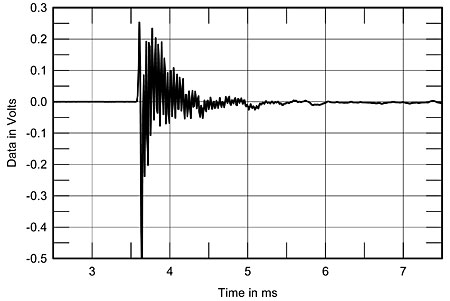
Fig.7 Merlin Excalibur, impulse response on tweeter axis at 50" (5ms time window, 30kHz bandwidth).
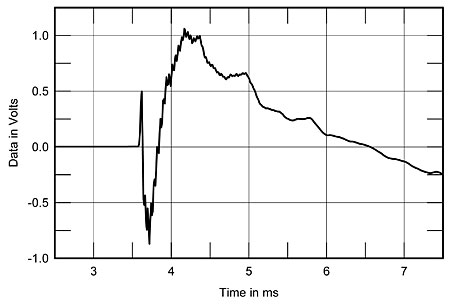
Fig.8 Merlin Excalibur, step response on tweeter axis at 50" (5ms time window, 30kHz bandwidth).
The waterfall plot calculated from the impulse response (fig.9) shows a basically clean treble region—this has always been a good tweeter—dominated by the ultrasonic resonance, but with resonant modes in the low-treble region where the midrange units and woofers overlap. These are somewhat down in level, however, and their effect on the speaker's quality is not known. Certainly JE was not bothered by any nasality, which usually accompanies problems in this region.

Fig.9 Merlin Excalibur, cumulative spectral-decay plot on tweeter axis at 50" (0.15ms risetime).
The Excalibur's unique construction meant that it wasn't possible to examine its cabinet's resonant behavior with an accelerometer. Listening with a stethoscope, however, revealed the rear and top decorative panels to be pretty well damped. The top halves of the side panels were reasonably inert, but there was a strong upper-bass mode present level with the lower woofer that presumably correlates both with the impedance irregularities in this region and the occasional confusion noted by JE. This mode could also be detected on the front baffle, but was much lower in level.
If you infer from my description of the measurements that the Merlin Excalibur II is a sub-optimally engineered loudspeaker, that is not the impression I mean to give. Admittedly, I expect very high-priced loudspeakers to inherently offer better performance than their lower-priced competitors. What might be forgivable at $3000/pair is, in my opinion, not so forgivable at three times as much. Rather, I feel that the Excalibur's restricted extension in the frequency extremes, combined with its forward, somewhat peaky midrange balance, mean that, contrary to JE's findings, it offers somewhat less than the sum of its expensive parts. The Excalibur needs to be very carefully auditioned by any prospective purchaser to determine whether what it does right is not offset by what it does wrong.—John Atkinson
Footnote 1: See JE's and my review in August (Vol.16 No.8, p.129).—John Atkinson
- Log in or register to post comments




































